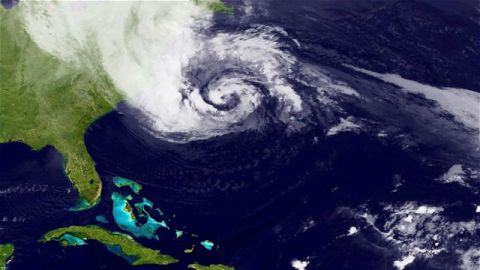Sandy. A Sobering Lesson from A Destructive Storm

A couple years ago, the government of New York City created a program on resilience to climate change and sea level rise. Many of the steps that program laid out are being put into action right now…evacuations…protection of critical infrastructure…preparations for repairing equipment and systems necessary to get the city running normally again. They didn’t wait until the final facts were in. As we would hope our leaders would anywhere, New York officials decided there was enough evidence that a risk might be coming, and that it would pose serious danger, that they’d better get ready, just in case. They looked at the facts, and carefully, rationally, analyzed what to do. That’s not how you and I usually do risk perception. We act far more from our gut and instincts than by brain and reason. If there is a silver lining in the fierce and destructive clouds of Hurricane Sandy, it may be a lesson about how our system of risk perception is making the risk of climate change much worse.
It seems frivolous, even disrespectful to the tens of millions of people in harms way from Hurricane Sandy, to discuss whether this life threatening weather is the result of climate change. Yes, sea level is higher than in the last hundred years (which increases flood damage), and sea temperatures are warmer (warm water feeds energy into these storms), and the melting arctic ice changes weather patterns coming from the north and creates conditions that cause east coast hurricanes to turn left and inland instead of right and out to sea.( BoingBoing.net Science Editor Maggie Koerth-Baker does a great job summarizing the science linking climate change to this historically freakish storm) But right now people are in danger. Some may die. Normal life is about to be disrupted for tens of millions of people, in many cases for weeks or more. Surely the larger but longer term issue of climate change can wait.
No, it can’t…because if there is a connection between this deadly weather and climate change…this is only the beginning. If the link is real, we need to take climate change more seriously than we have so far. Sandy may play a role in raising that concern. As have severe droughts worldwide, and floods, and other forms of extreme weather, Sandy is making powerfully, frighteningly, lethally clear that climate change can no longer be dismissed as an abstract threat that won’t happen until later and will probably only affect somebody else. If this destructive storm is yet another extreme weather event caused in part by climate change…we need to understand and experience this threat in that context.
The perception of risk is much more a matter of feelings than just a cold hard objective analysis of the facts. Climate change hasn’t really scared most of us much. After all, risks that won’t happen until later, and mostly threaten somebody else…the way large majorities have felt about climate change for years…just don’t ring our alarm bells the way the wind and rain and flooding lashing the Northeast right now do. This weather is dangerous. Scary. It is translating the possibility of climate change from a language our risk perception instincts don’t speak into the plainest loudest most direct message our animal brain responds to; DANGER! NOW! TO ME!!!!
Surveys have started to suggest that increasing extreme weather events globally these past few years may already be having this effect. (Lessons in Risk Perception From Rising Climate Change Concern) Hurricane Sandy will likely propel that shift. It will also probably further marginalize those who question, or outright deny, the evidence about climate change based largely on ideological grounds. These are people who, when pressed, say that climate change is just being promoted by those who prefer more government interference in individual lives or in the free market. That is anathema to libertarians and conservatives, who make up the majority of climate change skeptics. Their views on climate change are powerfully shaped by their deep ideological beliefs
But that ideologically informed view quickly pales in the face of the tangible serious threat now looming for tens of millions of Americans. It’s pretty hard to hear the forecast for what Sandy might do…to see that monstrous storm on TV…to look out the window at howling winds and hurtling debris and driving rain and flooded streets…and think more about one’s libertarian or conservative ideology than about staying safe and alive. Indeed, in a recent survey of public opinion about climate change, when people who don’t believe in climate change were asked how sure they were, for the first time since 2008 fewer than 50% were very sure (27%) or extremely sure (15%), a cumulative drop in the certainty of deniers of 15% since March 2012. Something is shaking their certainty, quite possibly the fact that the actual danger of climate change is looking more real, more personal, more now, and thus more threatening. And that survey was taken months ago.
Sandy is almost certain to feed that trend. And beyond that, this terrible storm may help us learn some important lessons about the way we perceive and respond to risk…with gut instinct more than cerebral analysis that may not be the smartest way to keep ourselves safe.
For now, though…I’m glad your power is on as you are reading this in the Northeast. (Wind gusts up to 70 mph outside Boston, lots of rain.) Good luck. And wherever you are, be safe.





